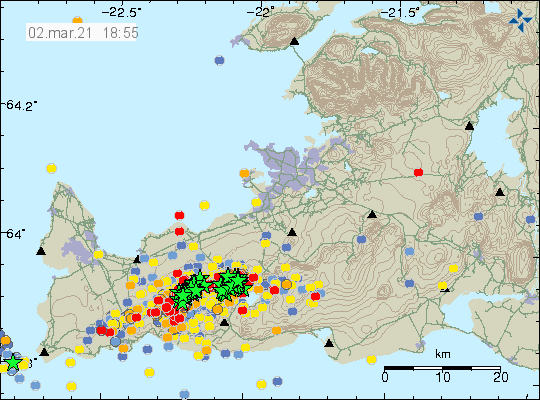This is a short update on the activity in Krýsuvík volcano. The activity has been confirmed to be only in Krýsuvík volcano and nothing is currently happening in Reykjanes volcano at the writing of this article.
Krýsuvík volcano started to show changes in late 2008 and early 2009 and that has been going on since then in low activity. Krýsuvík volcano is strange in that it does not have any shallow magma chamber in the top layers of the crust and Krýsuvík volcano size is unclear. This uncertainty shows in maps as different maps show different size and location of Krýsuvík volcano. While there is no shallow magma chamber in Krýsuvík volcano it does not rule out a deep, large magma chamber that does not show up on any seismometer since this magma chamber is located in the top layers of the mantle (10 to 30 km).

Largest earthquakes since midnight had a magnitude of Mw4,6 and since around 12:00 it has been rather quiet in Krýsuvík volcano when it comes to large earthquakes. A lot of smaller earthquakes have been taking during all this time and there is no sign of those stopping. The reason for all this earthquake activity is a magma dyke that is now breaking its path up to the surface from around 10 km depth. There are nothing to suggest that process is about to stop or slow down. Drop in activity as is now happening are common feature of this type of dyke activity and was seen just before the eruption in Bárðarbunga volcano (Holuhraun) in 2014 to 2015.
Earth Science department of University of Iceland released a pictures that show how this dyke in Krýsuvík volcano works and that image can be viewed here on Facebook.
If anything major happens I am going to post an update soon as possible. Next update is tomorrow (03-March-2021) if activity remains as it currently is.
Article updated at 20:25 UTC. Fixes in the text.

There is no shallow magma chambers in the Reykjanes Penninsula, If that was the case then you woud have collapse craters, and even shallow evolved melts. Reykjanes is almost purely feed by dike intrusions from the deep litosphere I think. The central volcanoes on Reykjanes are poorly developed. Perhaps Brennsteinsfjöll may resemble a long lava shield, and Hengil haves a subglacial lava pile construct near thingvallavatn.
But mostly eruptions in Reykjanes are short lived fissure eruptions. Some eruptions at Reykjanes Penninsula have made lava shields, but historical ones been fast short fissures.
4.1 Just hit Krysuvik. Looks like the small pause in large quakes may be over. Will be interesting to see if this is going to result in an eruption after so many years of inflation and seismicity.
What concerns me is the possibility that we are seeing the activation of the region in a longer term volcanic episode. Generally this area experiences activity episodes of a couple of hundred years out of every thousand and it has been over 700 years since the last one in this area. If that is the case, then we can expect various eruptions anywhere on the peninsula for a century or two but individual eruptions shorter lived. I am most concerned with the lava flow maps which show the possibility of the Reykjanesbraut route 41 being cut by lava flow should there be sufficient magma erupted. This would also cut one of the major power transmission lines to the Reykjanesbaer area.
Its starting a tremor was detected